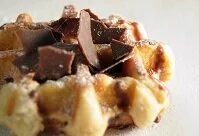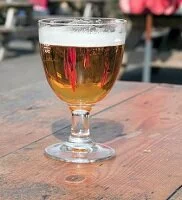Dining Etiquette

Waffle
Dining in Belgium is an odd combination of socialization and formality as there are some rules you must follow, but dining is almost always intended for socializing with others.
Family visits in Belgium are very rare as only close friends and family are invited to a local's house. If you do happen to be a close friend, then you probably already know that you should bring chocolates, if not, bring chocolates. No matter the setting though, arrive on time in an outfit that is formal; remember it is the host's job and honor to introduce everyone so let them do this instead of introducing yourself to the other guests.
As soon as you make it to the table, wait to sit until you are shown a seat and wait to sit down until invited to do so; generally women are asked to sit down first, then men take a seat. Dinner may begin with a toast, which you may stand for, then you'll begin eating. The Belgians eat in the continental style (knife in the right hand, fork in the left) and they always keep their wrists above the table within sight.
As dinner comes to an end, remember to finish all the food on your plate as leaving any is viewed as wasteful and impolite. Once the food is gone, place your fork and knife together to indicate that you are finished and compliment the host on your favorite dishes; the Belgians take great pride in their food and this, if given sincerely, is a great compliment.
If you're having a business dinner, there may be no actual business discussed as, again, meals are generally considered a time to get to know each other and to socialize. It's also important to note that if you're with your spouse, you most likely won't be seated together as couples are generally separated, but this gives you an opportunity to meet new people.
If dining out, restaurant bills will generally include a service charge so no additional tip is expected, although rounding up is common. For extraordinary service a tip is appreciated, but not common.
Drinks

Beer
There is no particular non-alcoholic drink to look for when in Belgium. The country offers milk, juices, coffee, tea, milk, and soft drinks like most countries, but none seem to stand out as unique or particularly local.
This quickly changes when you address alcoholic drinks. Beer is the drink of choice in Belgium and it's taken so seriously that most beers demand to be drunk from a different shaped glass (much like wine in neighboring France). Most beers in Belgium are produced by small local breweries and can be found in any restaurant or bar. For a less popular local drink try the jenever (or genierve), which is a distilled drink that can come in about any flavor and can be very strong so sip slowly. While it's nearly impossible to find a wider selection of high quality beers, international beers, wines, and hard liquors are also available.
Generally speaking, the tap water is safe to drink in Belgium, but check with locals for any particular regional differences. Also, many people may have troubles adjusting to the local tap water, as it will most certainly be different from what your system is used to.